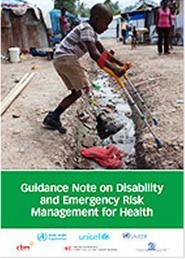Disability and emergency risk management for health
Launch of a guidance note by WHO and partners
http://www.who.int/hac/techguidance/preparedness/disability/en/ (ขนาดไฟล์: 167)

Emergencies can increase the vulnerability of people with disabilities, as people with disabilities may be less able to escape from hazards; may lose essential medications or assistive devices such as spectacles or hearing and mobility aids; or may be left behind when a community is forced to evacuate. People with disabilities may also have greater difficulty accessing basic needs, including food, water, shelter, latrines and health-care services. Following the earthquake and tsunami in Japan in 2011, statistics showed that the fatality rate for people with disabilities was twice that of non-disabled people.
Emergencies also create a new generation of people with disabilities due to injuries, poor basic surgical and medical care, emergency-induced mental health and psychological problems and breakdown in support structures and preventive health care. Estimates from some countries suggest that up to one quarter of disabilities before, during and after emergencies may be associated with violence and injuries. It is estimated that for every child killed as a result of violent conflict, three are injured and permanently impaired.
The Guidance note on disability and emergency risk management for health is a short, practical guide that covers actions across emergency risk management, such as risk assessment, prevention, preparedness, response, recovery and reconstruction. Developed primarily for health actors working in emergency and disaster risk management at the local, national or international level, and in governmental or nongovernmental agencies, the guidance note points out the health-related actions that are required to ensure that both mainstream and specific support are available and accessible to people with disabilities in emergencies.
ที่มา: http://www.who.int/hac/techguidance/preparedness/disability/en/ (ขนาดไฟล์: 167)
วันที่โพสต์: 5/11/2556 เวลา 03:29:37 
![]()
![]()
แสดงความคิดเห็น
รายละเอียดกระทู้
Launch of a guidance note by WHO and partners http://www.who.int/hac/techguidance/preparedness/disability/en/ Disability and emergency risk management for healthPeople with disabilities are disproportionately affected in emergencies and experience particularly high rates of mortality in these contexts. To mark International Day for Disaster Reduction 2013, CBM, the International Federation of Red Cross and Red Crescent Societies, the International Organization for Migration, the United Nations Children’s Fund, the United Nations Office for Disaster Risk Reduction and the World Health Organization release today a guidance note to highlight the needs of people with disabilities before, during and after emergencies. Emergencies can increase the vulnerability of people with disabilities, as people with disabilities may be less able to escape from hazards; may lose essential medications or assistive devices such as spectacles or hearing and mobility aids; or may be left behind when a community is forced to evacuate. People with disabilities may also have greater difficulty accessing basic needs, including food, water, shelter, latrines and health-care services. Following the earthquake and tsunami in Japan in 2011, statistics showed that the fatality rate for people with disabilities was twice that of non-disabled people. Emergencies also create a new generation of people with disabilities due to injuries, poor basic surgical and medical care, emergency-induced mental health and psychological problems and breakdown in support structures and preventive health care. Estimates from some countries suggest that up to one quarter of disabilities before, during and after emergencies may be associated with violence and injuries. It is estimated that for every child killed as a result of violent conflict, three are injured and permanently impaired. The Guidance note on disability and emergency risk management for health is a short, practical guide that covers actions across emergency risk management, such as risk assessment, prevention, preparedness, response, recovery and reconstruction. Developed primarily for health actors working in emergency and disaster risk management at the local, national or international level, and in governmental or nongovernmental agencies, the guidance note points out the health-related actions that are required to ensure that both mainstream and specific support are available and accessible to people with disabilities in emergencies.
จัดฟอร์แม็ตข้อความและมัลติมีเดีย
รายละเอียดการใส่ ลิงค์ รูปภาพ วิดีโอ เพลง (Soundcloud)

